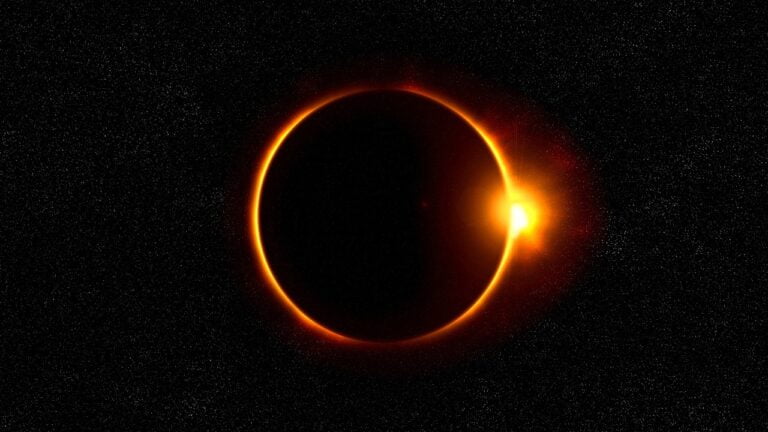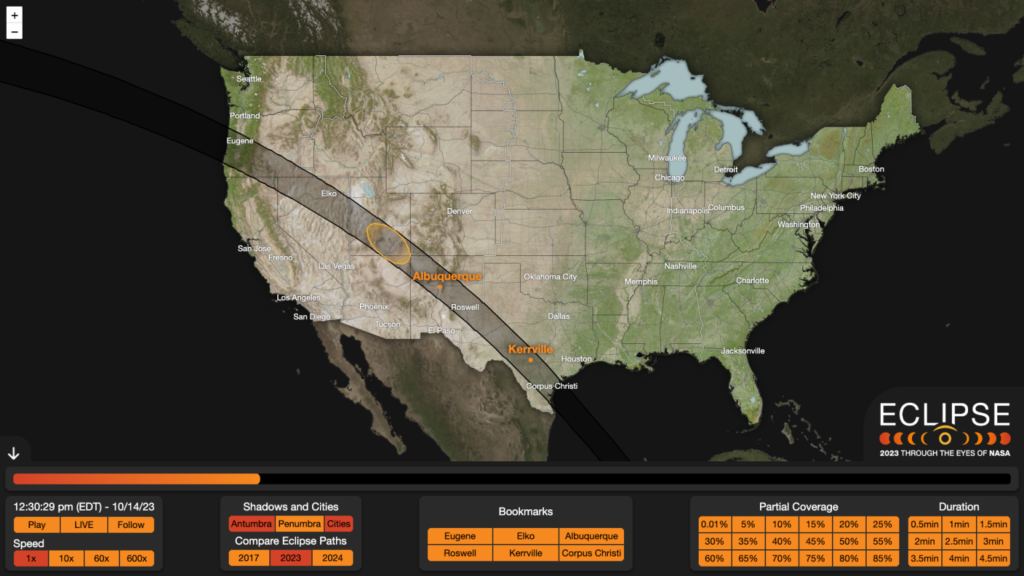Solar Eclipse 2023 – Skywatchers will witness a thrilling experience in the sky tomorrow, October 14 as an Annular Solar Eclipse will take place on Saturday. Also called the ‘Ring of Fire’, the Solar Eclipse will be visible across most American cities for the first time since 2012.

Solar Eclipse 2023, colloquially referred to as the “Ring of Fire,” occurs when the moon passes between the Earth and the sun. However, what makes this event distinct from a total solar eclipse is the moon’s apparent size. During an annular eclipse, the moon is at a point in its orbit where it appears slightly smaller than the sun. As a result, it doesn’t completely cover the sun’s disk. The sun’s outer rim remains visible, creating a mesmerizing ring-like effect, hence the name “Ring of Fire.”
Table of Contents
Solar Eclipse 2023: Date & Time?
This annular Solar Eclipse 2023 will take place tomorrow, Saturday, October 14, 2023, occurring just 4.6 days after the moon reaches apogee, its farthest point from the Earth.
The Annular Solar Eclipse will begin in Oregon at 9.13 am (PDT) and end in Texas at 12.03 pm (CDT), according to NASA.
It is pertinent to note that Saturday’s annular Solar Eclipse will be the last one that is visible from the United States until June 21, 2039.
Solar Eclipse Date | October 14, 2023 |
Solar Eclipse Day | Saturday |
Solar Eclipse Begins | 8:34 PM |
Solar Eclipse Ends | 2:25 AM |
What are the places to Witness the Ring of Fire?

The Solar Eclipse will be visible along a narrow path that crosses the USA, that is, from Oregon to Texas. After that, it will pass over Mexico’s Yucatán Peninsula, parts of Belize, Guatemala, Honduras, Nicaragua, Costa Rica, Panama, Colombia, and Brazil. A Partial Solar Eclipse will be visible from Alaska to Argentina, HT reported.
Check the table below to know the time and duration of the annular eclipse in your region:
Location | Partial Eclipse Begins | Annularity Begins | Maximum | Annularity Ends | Partial Eclipse Ends |
Eugene, Oregon | 8:06 a.m. PDT | 9:16 a.m. PDT | 9:18 a.m. PDT | 9:20 a.m. PDT | 10:39 a.m. PDT |
Alturas, California | 8:05 a.m. PDT | 9:19 a.m. PDT | 9:20 a.m. PDT | 9:21 a.m. PDT | 10:43 a.m. PDT |
Battle Mountain, Nevada | 8:06 a.m. PDT | 9:21 a.m. PDT | 9:23 a.m. PDT | 9:25 a.m. PDT | 10:48 a.m. PDT |
Richfield, Utah | 9:09 a.m. MDT | 10:26 a.m. MDT | 10:28 a.m. MDT | 10:31 a.m. MDT | 11:56 a.m. MDT |
Albuquerque, New Mexico | 9:13 a.m. MDT | 10:34 a.m. MDT | 10:35 a.m. MDT | 10:39 a.m. MDT | 12:09 p.m. MDT |
San Antonio, Texas | 10:23 a.m. CDT | 11:52 a.m. CDT | 11:54 a.m. CDT | 11:56 a.m. CDT | 1:33 p.m. CDT |
The Cosmic Mechanics Behind the Phenomenon.
To appreciate the beauty of the Ring of Fire solar eclipse, it’s essential to grasp the intricate dance of celestial bodies that bring about this extraordinary event.
The Moon’s Orbit: The moon orbits the Earth, following a path that isn’t perfectly aligned with Earth’s orbit around the sun. This orbital inclination means that the moon doesn’t always block the sun entirely during an eclipse.
The Moon’s Apogee: The moon’s orbit is elliptical, meaning it has a point closest to Earth (perigee) and a point farthest from Earth (apogee). During an annular solar eclipse, the moon is near its apogee, making it appear smaller in the sky compared to the sun.
Perfect Alignment: The magic of a Ring of Fire eclipse occurs when these factors align precisely. The moon’s smaller apparent size due to its apogee coincides with its transit between Earth and the sun. This alignment creates a breathtaking celestial display.
The Impact on Earth and Its Inhabitants
Visual Spectacle
The visual spectacle of a solar eclipse is a breathtaking experience. As the moon covers the sun, darkness descends, revealing the stunning corona, the sun’s outer atmosphere, which is otherwise invisible due to the sun’s intense brightness.
Scientific Significance
Beyond its mesmerizing beauty, solar eclipses hold great scientific importance. Researchers take advantage of these events to study the sun’s outer atmosphere, analyze its electromagnetic properties, and gain a deeper understanding of our solar system.
Cultural Significance
Throughout history, solar eclipses have evoked myriad interpretations and cultural significance. Many ancient civilizations associated eclipses with gods or supernatural events, often seeing them as omens. Today, solar eclipses continue to inspire art, literature, and folklore.
Safety Precautions
Just like any solar eclipse, observing the Ring of Fire eclipse requires the use of proper eye protection, such as eclipse glasses or solar viewers. Staring directly at the sun during any phase of the eclipse can be harmful to your eyes. It’s essential to prioritize safety when witnessing this celestial event.
FAQ's
Yes, On October 14, There Will Be An Annular Eclipse, Also Known As A “Ring Of Fire” Eclipse.
No, The Annular Solar Eclipse On October 14 Will Not Be Visible In India.
Across the United States from Oregon to Texas and continuing on to Central and South America
The Ring of Fire solar eclipse is a cosmic masterpiece, a manifestation of the celestial mechanics that govern our universe. This awe-inspiring event, with its captivating ring-like appearance, continues to intrigue and inspire both astronomers and casual observers. It serves as a reminder of the beauty and complexity of our cosmos, a testament to the precision and wonder of the celestial dance that unfolds above us.
You can find a large collection of solar eclipse resources, activities, visualizations, photos, and more from NASA at solarsystem.nasa.gov
The next time a Ring of Fire solar eclipse graces the sky in your region, make sure to have your eclipse glasses ready and prepare to be enchanted by this extraordinary celestial display.
